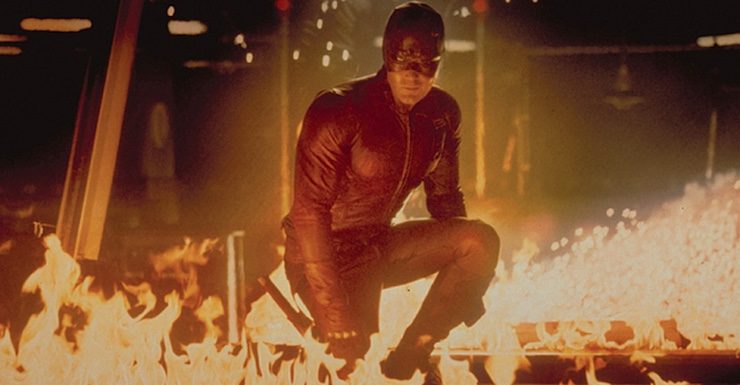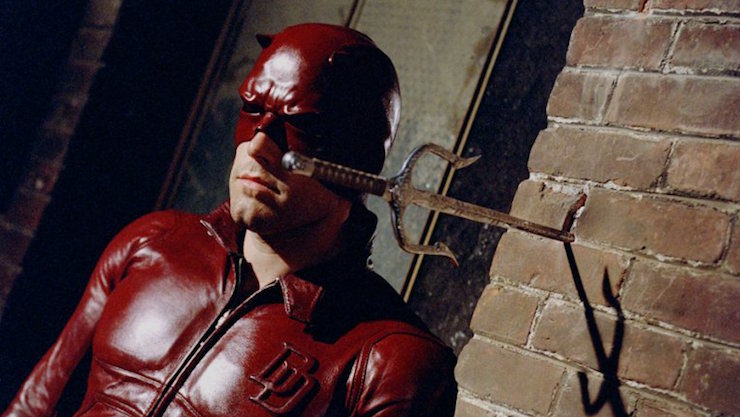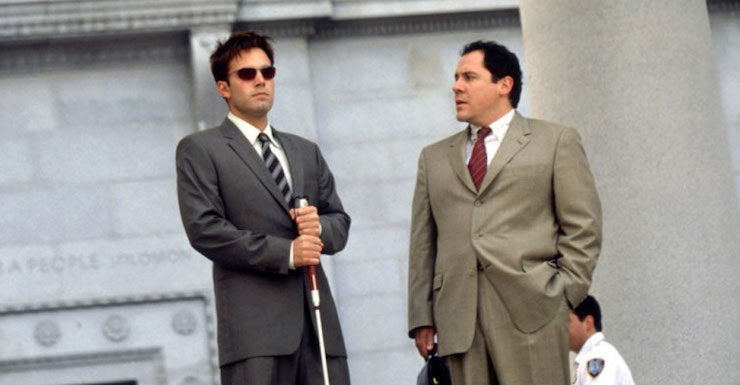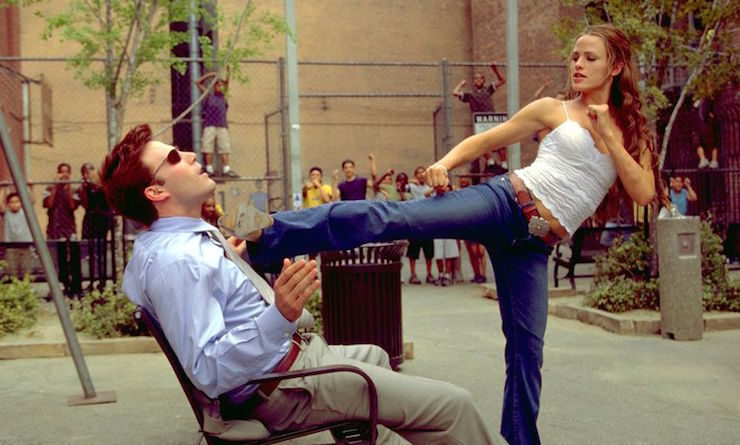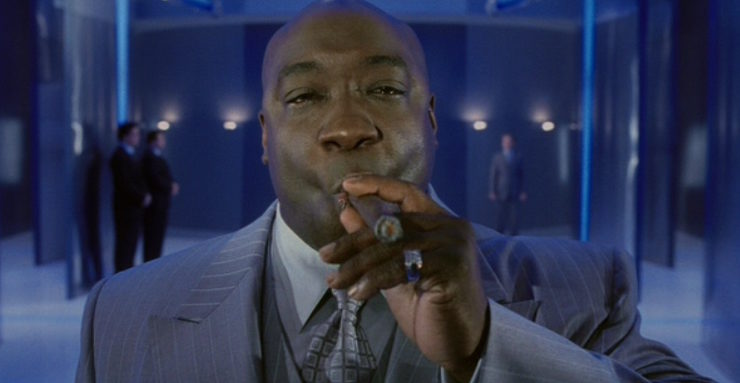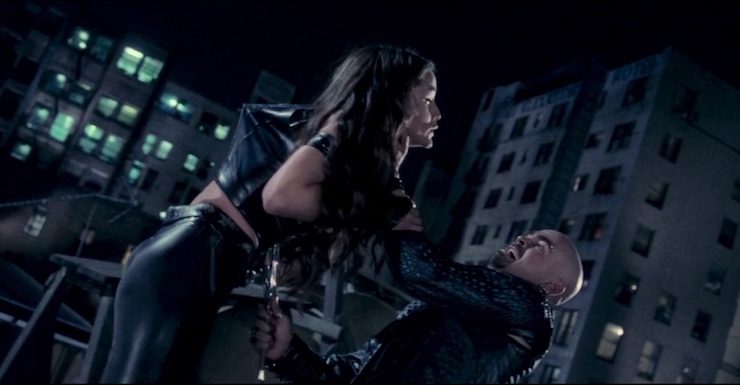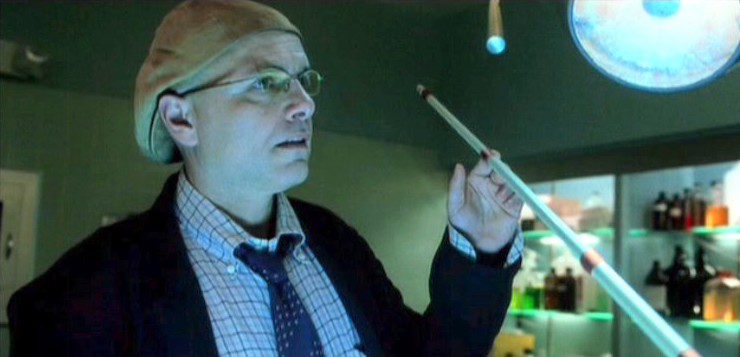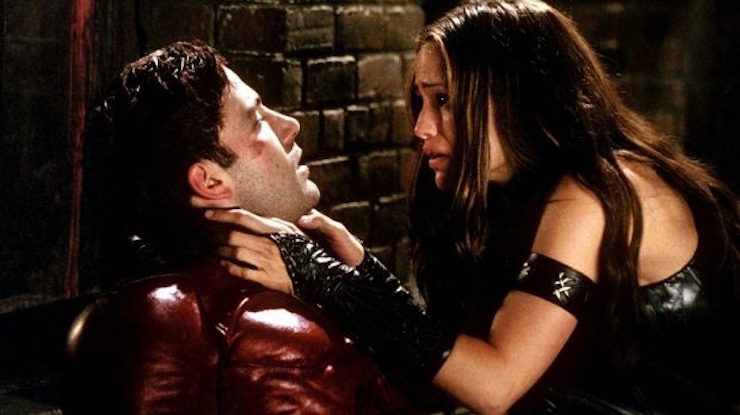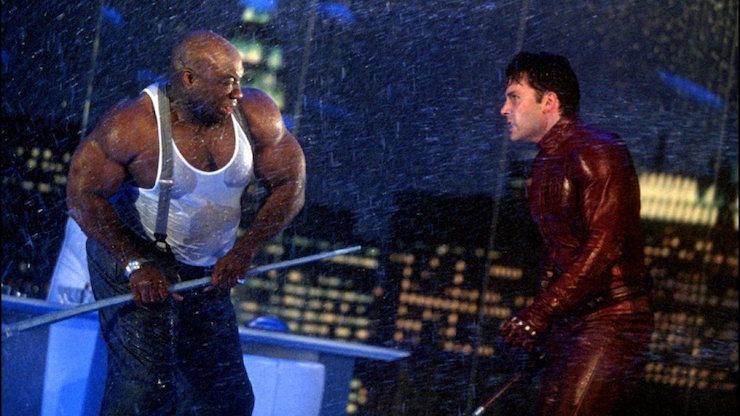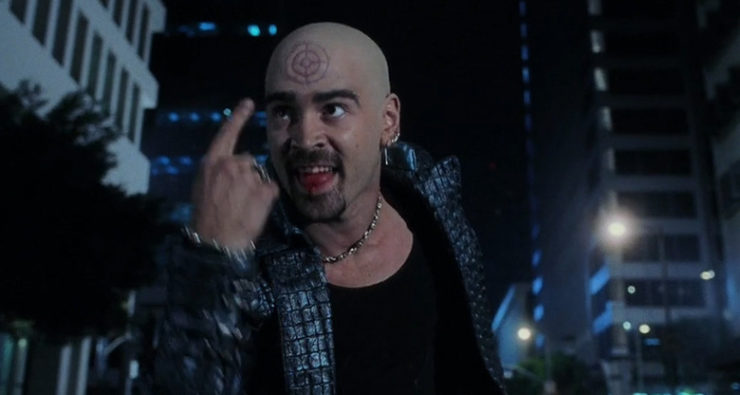Daredevil was created in 1964 by Stan Lee and Bill Everett, based on a character design by Jack Kirby. DD has one of the more ingenious superhero disguises, as his secret identity is a blind lawyer named Matt Murdock. Thanks to the early-Marvel catch-all of radiation = super-powers, young Matt was blinded by a radioactive canister, but his other senses were expanded a hundredfold.
The character was always something of a B-lister, never having the same level of prominence as Spider-Man and the Avengers and the Fantastic Four throughout the 1960s and 1970s, and in the 1980s, the title was on the verge of cancellation, when writer Roger McKenzie departed the title and his artist, Frank Miller, was given the chance to write the book. Under Miller’s guidance, the book was increased to monthly and became immensely popular, as Miller built on the darker tone McKenzie had started, and focused on DD as a city vigilante, fighting gangsters and such, in particular a minor Spider-Man villain, the Kingpin of Crime, as well as ninjas—lots of ninjas.
DD’s popularity meant that the spate of early 21st-century movies featuring Marvel characters almost had to include ol’ Hornhead.
Miller’s work vaulted Daredevil to the A-list. In addition to bringing in the Kingpin, he also utilized several elements that previous writers had created, from the incredibly skilled assassin Bullseye (created by Marv Wolfman) to Daily Bugle reporter Ben Urich (created by McKenzie). Urich actually figured out that DD and Murdock are one and the same.
Perhaps the biggest thing Miller did, though, was a retcon regarding Murdock’s pre-Daredevil past. He introduced Elektra Natchios, a diplomat’s daughter whom Murdock met while he was at Columbia University. They had a tumultuous relationship, he confided his secret to her, but then her father was killed, and she went home.
He went on to become a superhero, she went on to become a ninja assassin, and their tumultuous relationship got even more so when they crossed paths again years later. And the issue in which she died at Bullseye’s hands, issue #181, remains regarded as a classic comic book. She was later resurrected, and has continued to be a presence in DD’s life, and elsewhere in the Marvel milieu.
Like so many Marvel properties, Daredevil was optioned by a studio. The backdoor pilot for a DD TV show in The Trial of the Incredible Hulk didn’t come to anything, so they sold the film option to 20th Century Fox, which wound up being the first of many. It bounced around to Columbia (after failed negotiations with Disney), and finally New Regency, who used Fox to distribute it. Cha cha cha. Chris Columbus was attached for some time, and he even wrote a script, then Mark Steven Johnson was brought in to write a new script, and when the rights settled with New Regency, Johnson was also hired to direct.
Early-21st-century “it” couple Ben Affleck and Jennifer Garner were cast as Daredevil and Elektra, respectively. (Garner would star in a solo spinoff two years later, which we’ll cover next week, and it was meeting on this set that led to their being that couple.) Michael Clarke Duncan was cast as the Kingpin, with Colin Farrell as Bullseye. While Kingpin is white in the comics—and the other two times he’s been done on screen he’s been played by John Rhys-Davies and Vincent D’Onofrio—he was cast with a black actor here. Having said that, Duncan actually looks most like the Kingpin of the comics of the three of them (though all three have the requisite massive physicality required for the role).
The rest of the cast included longtime character actor Joe Pantoliano as Urich, David Keith and Erick Avari as the fathers of, respectively, Murdock and Elektra, and Jon Favreau as Murdock’s law partner Foggy Nelson. (Five years after this, Favreau would be one of the first movers and shakers of the Marvel Cinematic Universe, directing Iron Man and appearing in it as Happy Hogan.) Paul Ben-Victor, Jude Ciccolella, Leland Orser, and Robert Iler rounded out the cast. It was particularly entertaining in 2003 to see Iler, who played Anthony Soprano Jr. on The Sopranos, as a bully.
Daredevil became one of the most successful February releases in history, but given the movies that are generally released in February, this is rather like being the finest ice skater in the Bahamas. Critical response was mixed, and when Elektra failed at both the box office and critically, the planned DD sequel (which would possibly have adapted the “Born Again” storyline by Miller and David Mazzucchelli) never came to be. Aside from a cameo in Elektra, Hornhead wouldn’t be seen on screen again until 2015 when Marvel’s Daredevil would inaugurate Netflix’s collection of MCU shows.
“I need a fucking costume!”
Daredevil
Written and directed by Mark Steven Johnson
Produced by Gary Foster and Amon Milchan and Avi Arad
Original release date: February 14, 2003
Daredevil is clutching a cross atop a church. He falls down into the church itself, where Father Everett finds him. A voiceover talks about how your life flashes before your eyes when you’re dying, and that prompts a flashback…
Young Matthew Murdock is tormented by bullies growing up in Hell’s Kitchen. His father is Jack Murdock, a former boxer who now works as an enforcer for a mobster named Fallon. However, Jack’s been lying to Matt and when Matt discovers the truth, he runs away angrily, only to get involved in an accident that causes radioactive waste to hit his eyes.
While the gunk blinded him, his other senses are heightened greatly. He can use his increasing hearing as a kind of sonar, his increased touch enables him to hone his athletic skills, and he soon becomes quite the bad-ass. He beats up the bullies who were after him, and also saves the life of an old man who looks just like Stan Lee from being run over while crossing the street.
Jack makes Matt promise to make something of himself, to become a doctor or a lawyer. Jack also gets back into boxing, but he’s still in Fallon’s pocket. Fallon orders him to take a dive, but with Matt in the audience watching (well, listening), Jack wins the fight, only to get pounded to death by one of Fallon’s enforcers, a big guy from the Bronx named Wilson Fisk, who leaves a rose on the corpse.
Matt grows up and goes to law school, starting a practice with his best friend Franklin “Foggy” Nelson. Matt insists on only taking clients who are innocent, and he can tell who’s innocent or guilty by listening to their heartbeats. Most of the cases are pro bono, too, or at the very least are clients who can’t afford lawyers. (One client pays with fluke.) Foggy wants to branch out to actual rich and possibly guilty clients, but Matt insists.
In addition, Matt has honed his athleticism and use of his enhanced four remaining senses to dress up in a red devil outfit (inspired by the devil-style outfit Jack wore) and dispense justice when the law isn’t enough. We see him in a case against a rapist named Jose Quesada. Matt and Foggy lose the case, and so Daredevil chases down Quesada from a bar and into the subway, where DD watches him get run over and killed by the C train. Later, he stops a mugging and chases the bad guy into a building. A kid observes DD beating the crap out of the mugger and cowers in fear, but DD insists that he’s not the bad guy. The kid looks unconvinced.
Battered and bruised, Matt returns home and showers and tends his wounds. He hears a woman getting shot and killed as he’s getting into his isolation chamber for sleep, but does nothing about it.
While Foggy and Matt are in a coffee shop, a woman walks in. Matt immediately starts hitting on her for reasons that aren’t particularly clear. He gives her his name but she doesn’t give hers as she walks out. Matt follows her and they wind up having a friendly sparring session in a playground. She introduces herself as Elektra Natchios (while holding a side kick near his throat), the daughter of Nikolas Natchios, the billionaire.
New York Post reporter Ben Urich has been doing stories on Daredevil—most people believe him to be an urban legend—and also has been gathering evidence on the so-called “Kingpin” who runs all organized crime in New York City. Not everyone believes he exists either, but even those who do believe don’t know who he is.
As it happens, it’s Fisk, who has risen to prominence as the head of Fisk Corporation, and Nikolas is one of his investors. However, he wants no part of this anymore, and asks Fisk to buy him out.
Elektra tracks down Matt and he takes her to a rooftop he used to love as a kid, as it provided a great view of the city. Their romantic interlude is cut short when his hyper senses pick up a crime in progress and he leaves her to help the victim as Daredevil.
The woman Matt heard getting shot before sleeping was a prostitute, and they found a man named Dante Johnson passed out nearby. Johnson hires Nelson and Murdock to defend him. Matt is confused, though, as Johnson is telling the truth—but Detective McKenzie, the cop who seems to have set Johnson up, also appears to be telling the truth.
Fisk sends for an Irish assassin who goes by the sobriquet “Bullseye.” Bullseye can kill anyone with anything—he kills a bartender he doesn’t like in Ireland with paperclips, and suffocates his seatmate on the plane to New York with peanuts.
Matt confronts McKenzie, and discovers that he has a pacemaker, so that the heartbeat trick won’t work. McKenzie also says that the Kingpin, whoever he is, calls all the shots and there’s nothing some pissant lawyer can do about it.
Bullseye goes after Nikolas. Daredevil tries to stop him, but Bullseye grabs DD’s billy club, and uses it to kill Nikolas. Both Elektra and the cops believe that DD killed Nikolas. Fisk is pleased, as DD has been a thorn in his side for a while now and having him be wanted for murder works out nicely. (Of course, he’s already wanted for the murder of Quesada, but never mind.)
A forensic scientist shows Urich the murder weapon in the Natchios case, and Urich recognizes it as Matt’s cane.
Elektra goes after Daredevil, stabbing him in the shoulder with a sai. She unmasks him and is appalled to realize that it’s Matt. She believes Matt (a bit late) when he says he didn’t kill Nikolas, and then Bullseye shows up and Matt says he killed Nikolas. (How everybody found each other on this rooftop is left as an exercise for the viewer.)
Bullseye kills Elektra. Daredevil goes after Bullseye. They wind up at the church where the movie started, and we’re back full circle. They fight each other, Bullseye realizing that loud sounds annoy him when they crash into the organ and ringing the church bell to disorient him. During the fight, Bullseye reveals (a) that Fisk is the Kingpin and (b) that Fisk used to be Fallon’s enforcer and he was the one who killed Jack.
Daredevil tosses Bullseye out a stained-glass window and he lands on Urich’s car. Bullseye is taken to a hospital and put in traction, while Urich reveals that Fisk is the Kingpin, based on information he got from Nelson and Murdock—he has no proof, but he gives the cops Fisk’s right-hand man.
Battered and bruised, DD goes to Fisk’s tower. They fight each other, and DD breaks the Kingpin’s legs. But he doesn’t kill him, leaving him for the cops, declaring again that he’s not the bad guy, because he only committed assault instead of murder. Yay?
Johnson gets off and is eternally grateful. Urich warns Matt that he knows his secret, and he actually writes the article about who DD really is, but then he decides to delete it.
“You sure you’re blind?”
The biggest problem with Daredevil is that he’s always kind of been a second-rate Spider-Man. Numerous attempts were made to make DD stand out, but he always lagged behind the web-head as the top red-suited acrobatic hero in town. Even when Frank Miller revitalized the character in the 1980s, the character was often in Spidey’s shadow.
This extended to the movies, as Daredevil came out the February following the first Spider-Man film, and it was inferior in every way.
What’s frustrating is that it’s obvious that Mark Steven Johnson is familiar with the comics. He elegantly fuses together the various elements—DD’s origin, Elektra, Kingpin, Bullseye, Nelson and Murdock’s law career—into a single storyline. And I do like the fact that several of the side characters are named after creators who worked on the Daredevil comic—Lee, Everett, Mack, Bendis, Miller, Quesada, Colan, Romita, McKenzie—plus the cameos by DD writers Frank Miller and Kevin Smith, in addition to the ubiquitous Stan Lee. Johnson also re-creates several comics panels, most notably Bullseye’s murder of Elektra.
For all that he shows awareness of the character’s comics history in the abstract, though, he doesn’t get the context at all. To start with, the Matt/Elektra pairing is a complete failure. It worked in the comics (and in the Netflix series) because it was seeded in a flashback to Matt’s college days. The flashbacks give the relationship a chance to breathe, and gives it depth.
In this movie, there’s nothing. They barely know each other, Matt’s reasons for approaching her are never explained, and his going after her is one very small step below stalker. The playground fight is fun, but it’s the opening salvo of a long relationship, and we don’t get that. Instead we get two characters who suddenly are each other’s one twue wuv without anything to justify it. And everything happens so fast that Bullseye stabbing her has very little impact—made worse by the aping of the structure of Daredevil #181, but with none of that classic issue’s emotional resonance.
The worst, though, is that this isn’t a superhero movie, because at no point is Daredevil remotely a hero. Johnson systematically removes everything noble about Daredevil, starting with his origin. In the comics, Matt was blinded saving the life of an old man. In the movie, it’s just a dumb accident. At no point anywhere in the film does Matt or DD act heroic.
To make matters worse, Johnson has no understanding of how the justice system works. It’s bad enough that Daredevil murdered Quesada in cold blood, a moment at which I lost any interest in the character. But to make matters worse, DD only went after Quesada after the latter was declared innocent in a rape case against Matt and Foggy’s client.
Here’s the thing: victims of crimes don’t have lawyers in criminal cases. The district attorney’s office prosecutes the alleged perpetrators. The only way for Nelson and Murdock to be representing a rape victim in a courtroom is in a civil case, where the burden of proof is far less than it is in a criminal case.
And Matt and Foggy still lost. Which doesn’t mean that the justice system failed, it means that Matt and Foggy failed as lawyers. And because Matt and Foggy are shitty lawyers, Matt decided to suit up as DD and commit murder.
At one point, DD tells a little kid that he isn’t the bad guy, and he repeats it, hoping he can convince himself. He never convinced me. Supposedly he’s better by the end because he “only” broke Fisk’s legs (likely crippling him for life) and threw Bullseye out a window (almost definitely crippling him for life), but that just makes him a different class of criminal. It’s left annoyingly unclear why, exactly, Urich doesn’t expose Daredevil, as he’s a violent vigilante who shows no evidence of even being beneficial to the community.
For the second time on this site, I’ve done a rewatch of a movie I hated, which had a later director’s cut. In both cases—the other one is Star Trek: The Motion Picture—I never saw the director’s cut until I did the rewatch here on Tor.com. In both cases, I was told repeatedly that the director’s cut would cure all the ills of the theatrical cut.
In both cases, those people were full of it, as the director’s cut is just as bad as the theatrical release. The subplot with Johnson (played with amusing goofiness by Coolio) and Detective McKenzie (played with Jude Ciccolella’s usual sliminess) is an unfocused mess that displays more of Matt and Foggy’s lawyerly incompetence. (Talking to the wall? Really?) And it’s never made clear what evidence, exactly, was provided to help bring Fisk down. The additions in the director’s cut add nothing of consequence, and still keeps in everything that’s actively bad in the film
That includes the two leads. While the supporting cast is very strong, Ben Affleck is phony and awful for the most part. He’s only good when he allows himself to relax, which is in his romantic scenes with Jennifer Garner’s Elektra and in his delightful banter with Jon Favreau’s Foggy. But as the square-jawed vigilante, he’s dreadful. Garner’s not much better, though she has the physicality for the role. However, she never sells the tragedy. Elektra is a complex character who lost everyone she loved and turned to violence, but in Garner’s hands, she’s a talentless dilettante who pouts a lot and doesn’t even know to tie her hair back when she goes out to kill people.
It’s too bad, because they’re surrounded by great performances. Michael Clarke Duncan is a letter-perfect Kingpin (he’s the best of the three live-action Fisks, and that’s with no disrespect to John Rhys-Davies or Vincent D’Onofrio, who were both also superb), Joe Pantoliano is, as always, a delight as Urich, Favreau’s Foggy is hilarious, David Keith was born to play an over-the-hill pugilist, and Colin Farrell is having such a blast as Bullseye I found myself rooting for him more than DD. (Having said that, he’s a little too over the top overall, and the movie could have done with less of him.)
However, the strength of the support isn’t enough to counteract the drag effect of the leads or of the script’s inability to understand the lead character. Johnson’s directing is fine—the film’s lovely, even if the CGI is noticeably weaker than it was in contemporary Marvel films (even Hulk had better CGI)—and his use of sound is particularly impressive. I would’ve liked it if the film didn’t go out of its way to contrive rainstorms to make DD’s life easier, but whatever.
Ultimately, though, this movie winds up being just like the comic: it’s a weak version of Spider-Man.
However, it did spawn a spinoff with Garner. Next week, we’ll look at Elektra.
Keith R.A. DeCandido‘s birthday was this past week. Please wish him a happy birthday in the comments.










